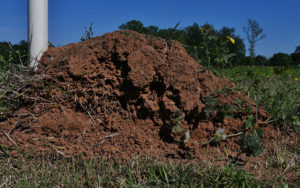by Adam Russell, Texas A&M AgriLife Communications

A ‘dead’ fire ant mound along a fence line in rural East Texas. (Texas A&M AgriLife Extension Service photo by Adam Russell)
DALLAS – Dealing with fire ants is no picnic, but getting rid of them can be as easy as Step 1, Step 2, according to Texas A&M AgriLife Extension Service experts.
Dr. Allen Knutson, AgriLife Extension entomologist, Dallas, said spring is a good time to control fire ants as this is when they search for food and build mounds, which makes them easier to locate.
Broadcast baits are the core of AgriLife Extension’s recommended treatment. The method becomes effective as temperatures begin to rise and ants begin to gather forage to feed their new brood, he said. But once hot, dry summer conditions set in, fire ants become less active and mounds become less visible as ants go deeper in search of moisture.
“It’s time now in central and southern Texas to put out baits. But we encourage homeowners in north central Texas to wait a few weeks to begin applying baits because of our cooler soil temperatures,” Knutson said. “It’s a good time to apply baits in spring as they are generally slow acting. It typically takes two to four weeks to see results from using baits containing indoxacarb, spinosad or hydramethylnon. Starting as early as possible provides more time to enjoy summer without fire ants.”
Knutson said baits with other active ingredients may require two to six months to achieve results, but often require fewer retreatments. So again, starting early has benefits.
Dr. Mike Merchant, AgriLife Extension urban entomologist, Dallas, noted fire ant activity, especially mound construction, is ramping up following the cool spring weather.
“By all evidence, this should be a typical fire ant year, with fire ants becoming more active over the next month or so,” he said. “Baits are still our best weapon against fire ants, and baiting season in North Texas runs from May to September. This is the time when fire ants will actively pick up baits and bring them to the nest.”
Fire ant mounds are often most visible at this time of year, Merchant said, so now is a good time to treat the biggest and worst mounds with an individual mound treatment, such as a liquid drench, or some form of granular, non-bait, insecticide or dust.
There will inevitably be small colonies that get overlooked by individual mound treatments, so AgriLife Extension still recommends broadcasting baits for fire ant control over the entire yards once the soil temperatures are warm enough for active fire ant foraging, usually around 70 degrees at 1-inch depth, Merchant said.
AgriLife Extension developed the Two Step methods of fire ant control to help consumers make sense of all the products on the market, Merchant said. The Two-Step Program is described in the attached bulletin and can be accessed via Merchants “Insects in the City” website: http://agrilife.org/citybugstest/files/2015/02/L-5070-1.pdf.
“The bulletin targets fire ant control in lawns and the home landscape,” Knutson said. “Where a product can be used, whether a lawn, garden, agricultural production pasture or orchard, is determined by the insecticide label. Users should read the pesticide label to be sure the site they are treating is listed on the product label.”
Products labeled for fire ant control are commonly sold as baits or individual mound treatments, Knutson said. A third category includes a few products that are broadcast over the lawn and kill ants by contact.
The first step in the Two-Step Method is application of a fire ant bait to the treatment area, Knutson said. Baits have the advantage in that users don’t have to find each fire ant colony and treat them directly. They are also are less costly in terms of time and amount of product needed when treating a large area.
“Fire ant colonies can be difficult to find, especially over a large area,” Knutson said. “With baits, ants pick up the bait and return it to the nest.”
However, baits are slow to work, Knutson said.
For those fire ant colonies in high traffic areas, such as around a mailbox, that must be controlled quickly, follow Step 2 and treat these mounds individually with a contact insecticide.
“Most products applied directly to the mound kill the colony in 1-2 days,” Knutson said. “If the area has just a few mounds, then it may not be necessary to apply bait. Just go to Step 2.”
Baits do have a limited shelf life, Merchant said. He advises users to discard bait products opened for more than a few months. Users should also make sure products they purchase from stores are not more than two years beyond their production date. If users are not sure of the age of the bait, apply the product around an active fire ant mound. If ants gather the bait and take it underground within a few minutes, it should be fresh and ready to use, he said.
“Many native ant species are beneficial in that they compete for food with fire ants, and some also attack new fire ant queens as they attempt to start a new colony,” Knutson said. “Insecticides for fire ants also kill native ants, thus only use these insecticides if fire ants are present.”
